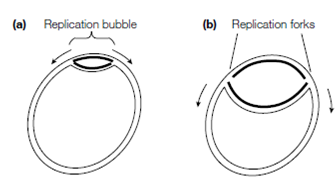Replication forks:
Whenever the bacterial circular chromosome is replicated the replication begins at a single source. The double helix opens up and both strands serve as template for the synthesis of new born DNA. The DNA synthesis then proceeds outward in the both directions

figure: Replication of the bacterial circular chromosome. Replication starts from a single origin and proceeds bi-directionally (a) moving around the chromosome with time (b). The two replication forks eventually meet and fuse. The two circular daughter DNA molecules produced each have one original template DNA strand (thin line) and one new strand (thick line).
from the single origin instance for it is bi-directional. The products of the reaction are two daughter double-stranded DNA molecules every of that has one original template strand and one strand of newly synthesized DNA. Therefore, replication is semi-conservative. The region of replicating DNA related with the single origin is called a replication bubble or replication eye and consists of two replication forks moving in opposite directions around the DNA circle that is described in the above figure.